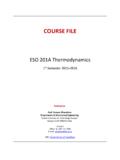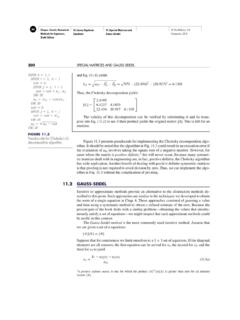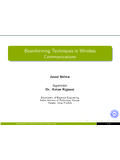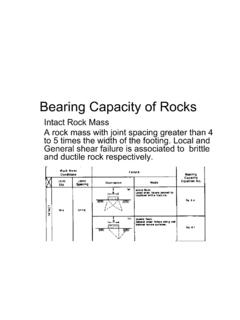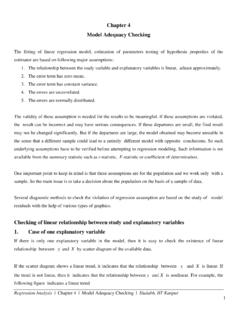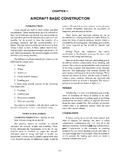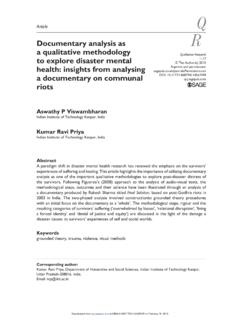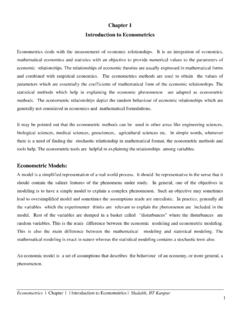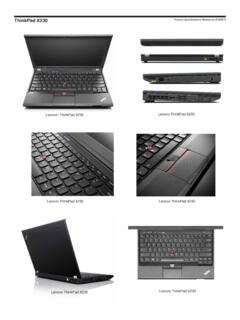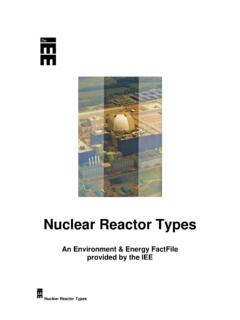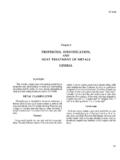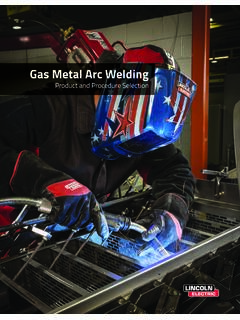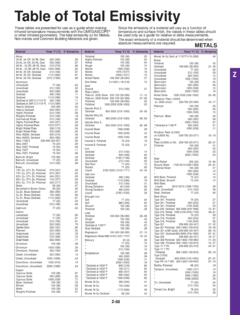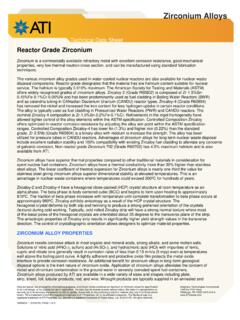Transcription of AIRCRAFT BASIC CONSTRUCTION
1 CHAPTER 4 AIRCRAFT BASIC CONSTRUCTIONINTRODUCTIONN aval AIRCRAFT are built to meet certain specifiedrequirements. These requirements must be selected sothey can be built into one AIRCRAFT . It is not possible forone AIRCRAFT to possess all characteristics; just as it isn'tpossible for an AIRCRAFT to have the comfort of apassenger transport and the maneuverability of afighter. The type and class of the AIRCRAFT determine howstrong it must be built. A Navy fighter must be fast,maneuverable, and equipped for attack and defense. Tomeet these requirements, the AIRCRAFT is highly poweredand has a very strong airframe of a fixed-wing AIRCRAFT consists of thefollowing five major units:1. Fuselage2. Wings3. Stabilizers4. Flight controls surfaces5. Landing gearA rotary-wing AIRCRAFT consists of the followingfour major units:1. Fuselage2. Landing gear3. Main rotor assembly4. Tail rotor assemblyYou need to be familiar with the terms used foraircraft CONSTRUCTION to work in an aviation STRESSLEARNING OBJECTIVE:Identify the fivebasic stresses acting on an primary factors to consider in aircraftstructures are strength, weight, and reliability.
2 Thesefactors determine the requirements to be met by anymaterial used to construct or repair the must be strong and light in weight. Anaircraft built so heavy that it couldn't support more thana few hundred pounds of additional weight would beuseless. All materials used to construct an AIRCRAFT mustbe reliable. Reliability minimizes the possibility ofdangerous and unexpected forces and structural stresses act on anaircraft when it is flying and when it is static. When it isstatic, the force of gravity produces weight, which issupported by the landing gear. The landing gear absorbsthe forces imposed on the AIRCRAFT by takeoffs ,anymaneuverthatcausesacceleration or deceleration increases the forces andstresses on the wings and on the wings, fuselage, and landing gear ofaircraft are tension, compression, shear, bending, andtorsion. These stresses are absorbed by each componentof the wing structure and transmitted to the fuselagestructure.
3 The empennage (tail section) absorbs thesame stresses and transmits them to the fuselage. Thesestresses are known asloads, and the study of loads iscalled astress are analyzed andconsidered when an AIRCRAFT is designed. The stressesacting on an AIRCRAFT are shown in figure (fig. 4-1, view A) is defined of stretching an object or pulling at its is the resistance to pulling apart or stretchingproduced by two forces pulling in opposite directionsalong the same straight line. For example, an elevatorcontrol cable is in additional tension when the pilotmoves the control forces acting on an AIRCRAFT move toward eachother to squeeze the material, the stress is calledcompression. Compression (fig. 4-1, view B) is theopposite of tension. Tension ispull, and compression ispush. Compression is the resistance to crushingproduced by two forces pushing toward each other inthe same straight line.
4 For example, when an airplane ison the ground, the landing gear struts are under aconstant compression a piece of paper with scissors is an exampleof a shearing action. In an AIRCRAFT structure, shear ( , view D) is a stress exerted when two pieces offastened material tend to separate. Shear stress is theoutcome of sliding one part over the other in oppositedirections. The rivets and bolts of an AIRCRAFT experienceboth shear and tension (fig. 4-1, view E) is a combination oftension and compression. For example, when bending apiece of tubing, the upper portion stretches (tension)and the lower portion crushes together (compression).The wing spars of an AIRCRAFT in flight are subject tobending (fig. 4-1, view C) stresses result from atwisting force. When you wring out a chamois skin, youare putting it under torsion. Torsion is produced in anengine crankshaft while the engine is running. Forcesthat produce torsional stress also produce STRESSAll structural members of an AIRCRAFT are subject toone or more stresses.
5 Sometimes a structural memberhas alternate stresses; for example, it is undercompression one instant and under tension the strength of AIRCRAFT materials must be great enoughto withstand maximum force of varying ACTION OF STRESSESYou need to understand the stresses encountered onthe main parts of an AIRCRAFT . A knowledge of the basicstresses on AIRCRAFT structures will help you understandwhy AIRCRAFT are built the way they are. The fuselage ofan AIRCRAFT is subject the fives types of stress torsion,bending, tension, shear, and stress in a fuselage is created in severalways. For example, torsional stress is encountered inengine torque on turboprop AIRCRAFT . Engine torquetends to rotate the AIRCRAFT in the direction opposite tothe direction the propeller is turning. This force createsa torsional stress in the fuselage. Figure 4-2 shows theeffect of the rotating propellers. Also, torsional stresson the fuselage is created by the action of the aileronswhen the AIRCRAFT is an AIRCRAFT is on the ground, there is abending force on the fuselage.
6 This force occursbecause of the weight of the AIRCRAFT . Bending increaseswhen the AIRCRAFT makes a carrier landing. This bendingaction creates a tension stress on the lower skin of thefuselage and a compression stress on the top action is shown in figure 4-3. These stressesare transmitted to the fuselage when the AIRCRAFT is inflight. Bending occurs because of the reaction of theairflow against the wings and empennage. When the4-2 Figure 4-1. Five stresses acting on an is in flight, lift forces act upward against thewings, tending to bend them upward. The wings areprevented from folding over the fuselage by theresisting strength of the wing structure. The bendingaction creates a tension stress on the bottom of thewings and a compression stress on the top of the The resistance to pulling apart or stretchingproduced by two forces pulling in oppositedirections along the same straight lines isdefined by what term?
7 Q4-2. The resistance to crushing produced by twoforces pushing toward each other in the samestraight line is defined by what term?Q4-3. Define the term shear as it relates to anaircraft Define the term Define the term MATERIALSLEARNING OBJECTIVE:Identify thevarious types of metallic and nonmetallicmaterials used in AIRCRAFT AIRCRAFT must be constructed of materials thatare both light and strong. Early AIRCRAFT were made ofwood. Lightweight metal alloys with a strength greaterthan wood were developed and used on later currently used in AIRCRAFT CONSTRUCTION areclassified as either metallic materials or 4-2. Engine torque creates torsion stress in AIRCRAFT 4-3. Bending action occurring during carrier MATERIALSThe most common metals used in aircraftconstruction are aluminum, magnesium , titanium,steel, and their alloy is composed of two or more metals. Themetal present in the alloy in the largest amount is calledthebase metal.
8 All other metals added to the base metalare calledalloying elements. Adding the alloyingelements may result in a change in the properties of thebase metal. For example, pure aluminum is relativelysoft and weak. However, adding small amounts orcopper, manganese, and magnesium will increasealuminum's strength many times. Heat treatment canincrease or decrease an alloy's strength and are important to the AIRCRAFT industry. Theyprovide materials with properties that pure metals donot alloys are widely used in modernaircraft CONSTRUCTION . Aluminum alloys are valuablebecause they have a high strength-to-weight easy to fabricate. The outstandingcharacteristic of aluminum is its is the world's lightest structural is a silvery-white material that weighs two-thirds asmuch as aluminum. magnesium is used to makehelicopters. magnesium 's low resistance to corrosionhas limited its use in conventional is a lightweight, strong, corrosion-resistant metal.
9 Recent developments make titaniumideal for applications where aluminum alloys are tooweak and stainless steel is too heavy. Additionally,titanium is unaffected by long exposure to seawater andmarine AlloysAlloy steels used in AIRCRAFT CONSTRUCTION have greatstrength, more so than other fields of engineeringwould require. These materials must withstand theforces that occur on today's modern AIRCRAFT . Thesesteels contain small percentages of carbon, nickel,chromium, vanadium, and molybdenum. High-tensilesteels will stand stress of 50 to 150 tons per square inchwithout failing. Such steels are made into tubes, rods,and type of steel used extensively is stainlesssteel. Stainless steel resists corrosion and is particularlyvaluable for use in or near MATERIALSIn addition to metals, various types of plasticmaterials are found in AIRCRAFT CONSTRUCTION . Some ofthese plastics include transparent plastic, reinforcedplastic, composite, and carbon-fiber PlasticTransparentplasticisusedincanopie s,windshields, and other transparent enclosures.
10 Youneed to handle transparent plastic surfaces carefullybecause they are relatively soft and scratch easily. Atapproximately 225 F, transparent plastic becomes softand PlasticReinforced plastic is used in the CONSTRUCTION ofradomes, wingtips, stabilizer tips, antenna covers, andflight controls. Reinforced plastic has a highstrength-to-weight ratio and is resistant to mildew androt. Because it is easy to fabricate, it is equally suitablefor other parts of the plastic is a sandwich-type material ( ). It is made up of two outer facings and a centerlayer. The facings are made up of several layers of glasscloth, bonded together with a liquid resin. The corematerial (center layer) consists of a honeycomb4-4 HONEYCOMBCOREFACINGS(MULTIPLE LAYERS OF GLASS CLOTH)Anf0404 Figure 4-4. Reinforced made of glass cloth. Reinforced plastic isfabricated into a variety of cell and Carbon FiberMaterialsHigh-performance AIRCRAFT require an extra highstrength-to-weight ratio material.
